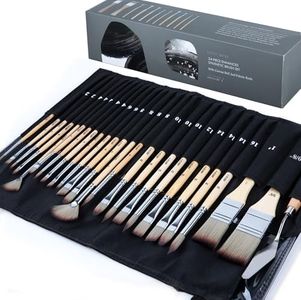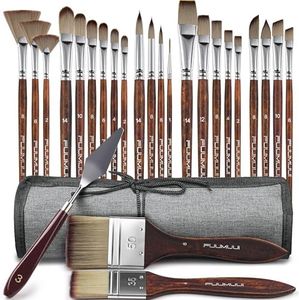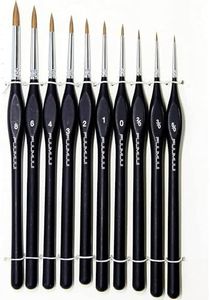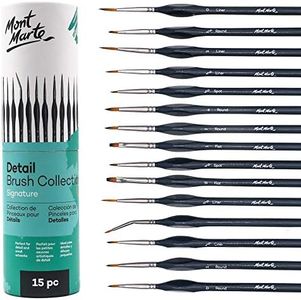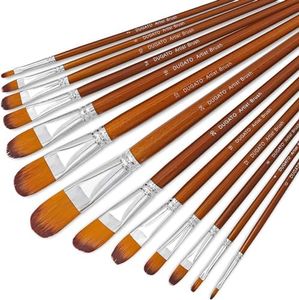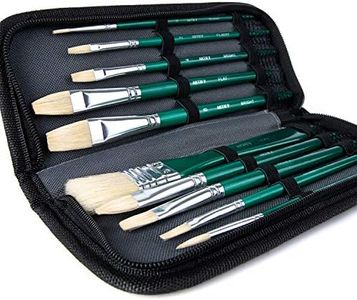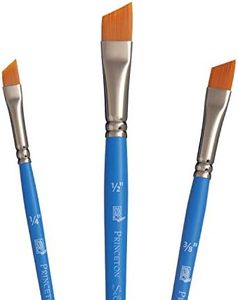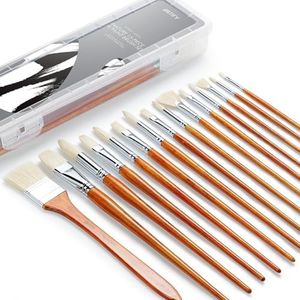We Use CookiesWe use cookies to enhance the security, performance,
functionality and for analytical and promotional activities. By continuing to browse this site you
are agreeing to our privacy policy
10 Best Oil Paint Brushes
From leading brands and best sellers available on the web.By clicking on a link to a third party's website, log data is shared with that third party.
Buying Guide for the Best Oil Paint Brushes
Choosing the right oil paint brushes can be both exciting and a little confusing, especially with so many shapes, sizes, and materials available. A good set of brushes enhances your painting experience, influences the mark-making, and makes it easier to achieve the style you want. To find your best match, it’s important to think about what subjects you want to paint, your personal technique, and how much care you want to put into maintaining your brushes.Bristle TypeThe bristle type refers to the material used for the hairs of the brush, which can be either natural or synthetic. Natural bristles, often made from hog hair, are stiff and ideal for thick oil paint and bold strokes, while softer natural types like sable are great for detail work and smoother blends. Synthetic bristles are usually smoother and more springy, often recommended for those wanting easier clean up or for vegan artists. Beginners or those painting with thick layers often lean towards hog bristle, while detailed or delicate painters might prefer softer options. Choose the type based on whether you need more control for fine work or robust strokes for texture.
Brush ShapeBrushes come in various shapes, including round, flat, filbert, and fan, each designed for different techniques and effects. Round brushes are versatile and good for lines and details, flats cover larger areas and make bold strokes, filberts are a blend of round and flat for softer edges, and fan brushes help with blending and creating natural textures like foliage. If you’re unsure, starting with a basic set that includes each shape allows you to discover what fits your painting style.
Brush SizeSizes are marked by numbers and indicate the thickness or width of the brush head. Smaller numbers mean finer brushes for details, while larger sizes are best for covering broad areas and making bold strokes. If you mostly paint large canvases or backgrounds, bigger brushes make the job easier, but for small canvases or intricate work, smaller sizes are more helpful. Consider what scale and level of detail your paintings will have to guide your choice.
Handle LengthBrushes generally come with either long or short handles. Long handles are preferred by oil painters who paint at an easel, as they allow for a more sweeping motion and let the artist stand back from the canvas. Short handles are better for tabletop work or for those who like to work up-close. Think about your workspace and how you like to paint to decide which handle feels more comfortable for you.
Ferrule QualityThe ferrule is the metal piece that connects the bristles to the handle. A high-quality ferrule will be made from brass or nickel-plated metals and will be tightly crimped to prevent bristles from falling out or the head from wobbling. Sturdy ferrules make brushes last longer and perform more consistently, so check for any looseness or obvious seams if you can inspect before buying.
Ease of CleaningOil paint brushes need regular cleaning to last long, and some bristle types or shapes are easier to clean than others. Synthetic bristles and simple shapes typically make cleaning faster, while densely packed or specialty-shape brushes can hold paint stubbornly. If you plan to paint frequently and want easy maintenance, choosing brushes that rinse clean quickly can save you time and effort.
